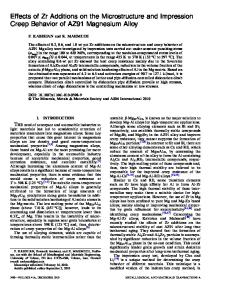Impression Creep Behavior of a Cast AZ91 Magnesium Alloy
- PDF / 934,388 Bytes
- 12 Pages / 593.972 x 792 pts Page_size
- 23 Downloads / 344 Views
ON
THE close attention paid by the automobile, aerospace, and electronic industries to light materials introduces magnesium alloys as a promising candidate for extensive use in these fields. Despite this attention, the use of Mg alloys in these industries, especially in the automobile and aerospace industries, is restricted, due to some associated disadvantages, such as poor cold workability, low corrosion resistance, high chemical reactivity, and a high thermal expansion coefficient.[1] Among magnesium alloys, those based on Mg-Al possess an excellent combination of superior castability, good corrosion resistance, acceptable mechanical properties, and reasonable cost.[2] However, the main problem involved in using Mg-Al–based alloys is the drastic drop in their high-temperature mechanical properties and creep resistance with increasing temperature to above 400 K. Generally, the low creep resistance of Mg-Al–based alloys with an aluminum content greater than 3 wt pct is attributed to the formation of b-Mg17Al12 precipitates at grain boundaries and interdendritic regions.[1–5] Despite significant room-temperature solid-solution hardening, increasing temperature causes noticeable softening and dissolution of b-Mg17Al12 such that hardening by solid solution F. KABIRIAN, Research Assistant, and R. MAHMUDI, Professor, are with the School of Metallurgical and Materials Engineering, University of Tehran, Tehran. Contact e-mail: [email protected] Manuscript submitted July 27, 2008. Article published online November 12, 2008 116—VOLUME 40A, JANUARY 2009
cannot compensate the abrupt drop in the mechanical properties caused by softening at elevated temperatures. It has been stated by Zhu et al.[6] that, although the eutectic b-Mg17Al12 contributes to the creep resistance by obstructing the dislocation annihilation (recovery) in dislocation creep or by inhibiting the grain-boundary migration or grain-boundary sliding in diffusional creep, b-Mg17Al12 precipitates tend to coarsen at elevated temperatures, thus losing their strengthening effect. Creep behavior analysis of some Mg-Al alloys in the as-cast condition has shown that AZ91 (Mg-9Al-1Zn) has significantly better creep resistance than other Mg-Al alloys in the temperature range 343 to 423 K. This has been attributed to dislocation hardening, solid-solution hardening, and the precipitation of b-Mg17Al12 during creep.[7] In other words, temperatures lower than 423 K are not high enough to soften b-Mg17Al12 particles or to diminish solid-solution hardening and, thus, the hardening by the solute atoms can be considerable. The dragging of dislocations by aluminum atoms has been proposed as a controlling mechanism for the creep deformation of Mg-Al alloys in the aforementioned temperature range, in which the contribution of grain-boundary sliding is not pronounced.[8] Regev et al.[9–11] have studied the creep behavior of the AZ91 alloy in both pressure-diecast and ingot forms with grain sizes of 15 and 300 lm, respectively, in the temperature range 393 to 453 K. While cavitation and cr
Data Loading...











